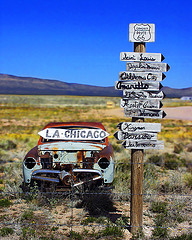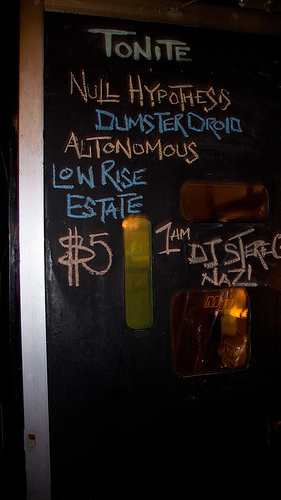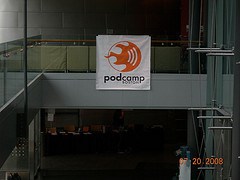My mother is a long-time volunteer for the American Red Cross. She is a retired teacher (special ed., eighth grade, which alone I think earns her a big shiny gold medal) and registered nurse, and now that she is retired she flies all over the place for the Red Cross, helping them set up shelters and large-scale disaster relief logistics. When she's home, she teaches CPR and First Aid and disaster preparedness classes and then she shows up in the middle of the night if your house burns down.
Voice Mail Archives
Past editions of Voice Mail, Beth Dunn's newsletter on writing and voice.
powerpoint presentations are just visual mad libs
Someone I follow on Twitter recently said, "When someone doesn't post for a while, I always wonder what wonderful secret project they're working on."
put something down on it

Chris Penn reflected today on the future of podcasting, in response to something Chris Brogan wrote about the fragmentation of social media, and as a result, of its community and events.
Chris has been putting out a very professional, targeted, and (from what I can tell) successful podcast called The Financial Aid Podcast. In today's post, he reflects on the really incredible time commitment necessary to really make a podcast work.
It takes a lot of time (and other resources) on a day-to-day basis to produce and promote a high caliber podcast like his. It also takes a serious, unflinching commitment of those resources over a long period of time to have a shot at any real, lasting success.
This is true for all social media projects, and it's important to discuss the long haul very explicitly, with all your internal stakeholders, before getting started.
It is so important that everyone agrees at the outset what success will look like, how it will be measured, at what intervals you will be measuring your target metrics, and what weight you will assign to each interval over time.
Now is the time to find out whether or not key people expect to see thousands of active community members on your site within three months, or if you can agree on making a somewhat more gradual, sustainable growth curve your goal.
And get it in writing. Remember that staff turnover in nonprofits is incredibly rapid, and plan for each interval, if necessary, being evaluated by an entirely different IT team, different full-time staff, different executive director, different board of directors.
Ideally, you want to create a document that, if sealed in a time capsule and opened up by strangers, would spell out exactly what your goals, strategies, and tactics are going to be, and what responses you plan to put into effect if different benchmarks are met -- or not.
It's a technology plan, or even a social media plan, and it should be integrated, if at all possible, with your development plan and your communications plan. Write it up, get your board to sign off on it. Record it in the minutes.
Putting together this kind of an integrated plan requires a lot more time, it's true, than just saying Let's start a blog/podcast/facebook group and see where it takes us. But it can also offer much greater returns, and can give you two solid legs to stand on when times are tight and people start eying your budget as potential fat to be trimmed.
As Penn writes,
There is far more yet to come, if you are willing to have the vision, commitment, and dedication to achieve long term success. If you’re not willing to make that commitment, that’s okay, but don’t expect the same results as the folks who are.
ROI: the null hypothesis

The We Are Media Project, to which I am a contributor, continues this week with Module 6: Considering the ROI of Social Media. For a summary of the materials produced for this module so far, read Beth Kanter's excellent summary here. For a review of what the We Are Media Project is all about, visit the wiki.
back it up, back it in

I went to Podcamp Boston 3 last weekend, despite being busier than I've been all year, because Podcamp is not to be missed.
For those of us who are deeply into social media -- whether it's blogging, podcasting, twittering, facebooking, flickring, or any combination of the above (and more) -- this is our chance to gather (gasp) in real life, meet face to face, and get each other up to speed on our latest projects, and get a feel for the current zeitgeist.
...
Who am I kidding. It's a tribal gathering. It is just flat-out exhilarating to be in a room full of like-minded people, people who are just as fascinated by all this, all this online nonsense that is simultaneously being heralded as the next great thing, the next great bubble, or simply a sign of (a) flaking off on the job, (b) extreme narcissism, or (c) downright anti-social tendencies.
Whatever the case, whatever you believe, this much is true: It is good to be among one's own. I was personally giddy with joy the whole time I was there, and the afterglow honestly hasn't faded yet.
Ironically for a conference full of hardcore Twitter users, Twitter was scheduled for some "routine maintenance" right in the middle of the day on Saturday. This was a fact that had escaped the notice of most attendees until the dreaded moment was upon us...
we are media - thoughts on evangelizing social media
This week's module in the We Are Media Project is How to be an Effective Evangelist for Social Media within a Nonprofit Organization.
the third thing

I've always loved the children's book Miss Rumphius.
and here's the play at the plate...
I've got very little time to spare these days and for the next little while, as we are fast approaching the date of my organization's major event on Sunday, August 3, at the same time as we are getting ready to launch our new website (about to launch in beta in about ten days - want to beta test it with us?).
lingua franca
co-curating the museum brand
Museums are among my favorite things in the world. When I travel, that's what I look for first: the museums.
